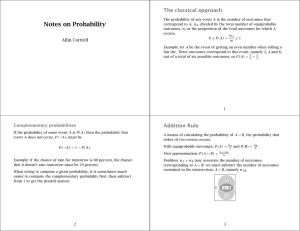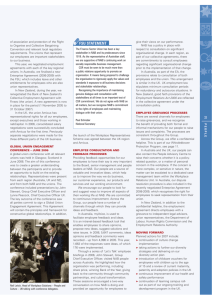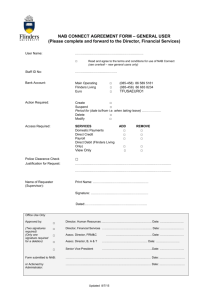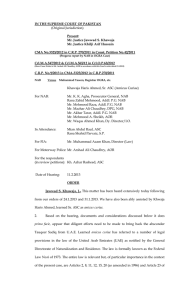DATA SET 3 DOCUMENT ANALYSIS SCHOOL PLANNING AND IMPLEMENTATION RESOURCES
advertisement
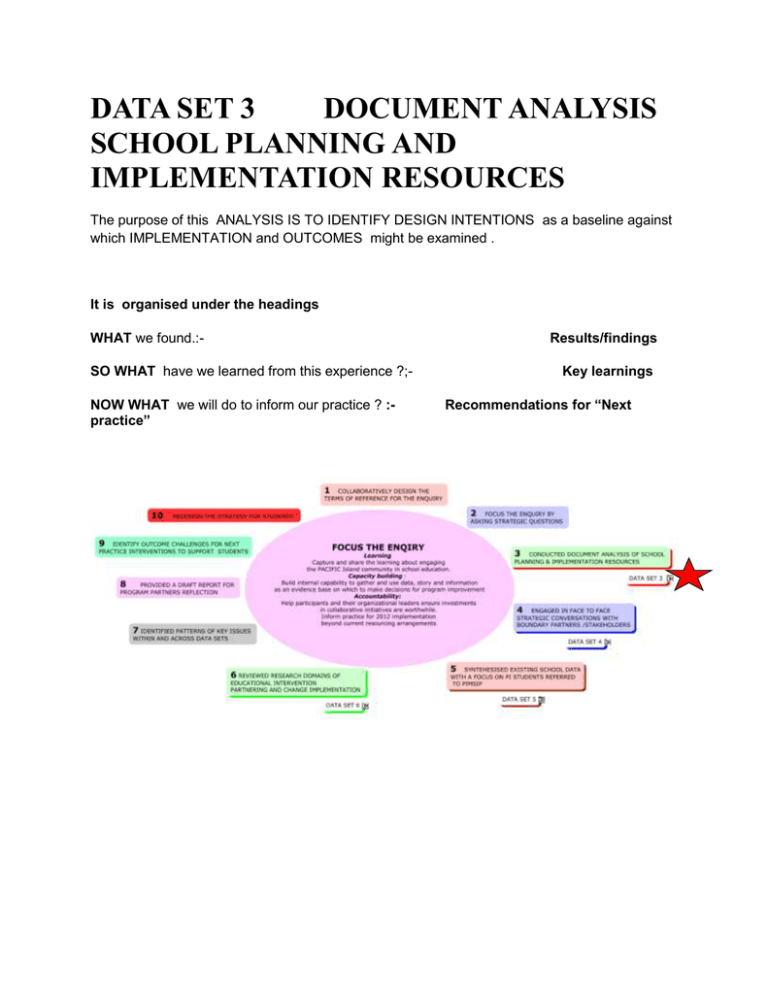
DATA SET 3 DOCUMENT ANALYSIS SCHOOL PLANNING AND IMPLEMENTATION RESOURCES The purpose of this ANALYSIS IS TO IDENTIFY DESIGN INTENTIONS as a baseline against which IMPLEMENTATION and OUTCOMES might be examined . It is organised under the headings WHAT we found.:SO WHAT have we learned from this experience ?;NOW WHAT we will do to inform our practice ? :practice” Results/findings Key learnings Recommendations for “Next WHAT we found.:- Results/findings Documents available to this review Documents not available to this review include Documented curriculum materials and teaching materials Completed PIMSIP referral forms Records of meetings of PIMSIP governance arrangements Implementation flowchart PIMSIP has been delivered in a context of changing people , partners and purposes Espoused Values, results , Implementation strategies and metrics of success Aspirational goals are more likely to be couched in value laden terms such as “respond to the cultural, emotional physical and community needs of pacific island young people An increase in cultural identity within the school and wider community (Relate cdp program Overview ) A greater understanding within the school community of Pacific Island and Maori young people and their specific needs ( NAB Schools First proposal ) building students‟ confidence in their relationships with other cultures in Australia and abroad (2010 School Annual Report ) Strategies are based on the hypothesis that increased engagement in class ,results in higher rates of attendance that leads to increased potential academic attainment NAB Schools First proposal a layered response to the situation and a wrap around model that is embedded within the whole school community is preferred (NAB Schools First proposal The longer term approach is to progress referred students through the phases of Engage, Aspire ; Inspire ( Relate cdp strategic plan 2010) Inputs and activities focus heavily on community engagement and the development of teacher awareness of cultural difference Community linkage – visitation program service agreement (Service Agreement ) Develop community mentoring network and training process (Nab proposal ) Strengthen teacher skills are an integral part of this program staff will receive skilling in cultural awareness, protocols and processes(Nab proposal ) Measures of success , when included, are more likely to be expressed in terms of hard data on attendance , attainment and school disciplinary absences with little emphasis on recognition and reward for the soft social capital development espoused in aspirational goals. Boundary partners/stakeholder groups STUDENTS 2010 35 STUDENTS 2011 11STUDENTS continue with PIMSIP 60 students not previously referred engaging 4 2010 20 STUDENTS 2011 9 STUDENTS continue with PIMSIP ??? 6 6 2010 32 STUDENTS 2011 17 STUDENTS continue with PIMSIP 18 STUDENTS not previously engaged participate in VAL active volunteering program Of the 87 students who participated in PIMSIP 2010 ,36 were referred again in 2011 ( 41 %) Some 34 FACTORS influencing student performance were identified in the student referral form.i The NAB proposal identifies the intention for VAL students to become the mentors and work with younger peers within the school community PARENTS The NAB proposal indicates a genuine willingness to work in partnership with Pacific Island and Maori parents and communities - an identified best practice cited by the Pacific Island Framework for Action in Education. There is an anticipated increase the involvement of parents in the life of the school community . COMMUNITY A semantic map of the NAB proposal identifies 50 uses of the word community in comparison with 2 of the word teacher Many of these focus on the role of “the community partner “ & “ community mentors “ as representatives of the school PI community. The community partner was engaged in 2010 and again in 2011 on the strengths of the 2010 School Annual report “ A partnership between Forest Lake SHS and Relate Community Development Program (CDP) specifically addressed identified needs of students of Pacifika and Maori cultural heritage. The positive outcomes of this partnership were used as the platform for a successful National Bank of Australia Schools‟ First Application (valued at $25000). The Service agreement identifies an agreement for the community partner to establish a Community linkage – visitation program DESIGNERS The role is not specifically mentioned in the documents examined . The function has been performed by one of the school guidance officers who , with team support was successful in securing the NAB Schools first seed funding of $25K TEACHERS The NAB Schools First Funding Application defines the following focus for teacher engagement Cultural awareness progressions by providing appropriate cultural training to increase teachers’ understanding of Pacific Island and Maori culture, structure and family system, as well as preferred learning styles. A word cloud generator of the 25 most commonly used works in the NAB Schools First Funding Application The service agreement does not mention any role for class teachers in the delivery of PIMSIP Relate cdp Program overview also fails to identify a specific role for class teachers who refer students to PIMSIP ADMINISTRATION Program governance structures for 2011 focussed on regular meetings for strategic team: comprised of, principal, guidance officer, and community partner develop and design the strategic and operational plan to meet monthly to finance and audit budget of the program to manage and review program delivery analyse the broader implications of the strategic plan school management team: comprised of the strategic team and deputy principal, middle school management and community development officer support delivery of the program communicate intent of program to the school community and wider community manage the referral process manage the reactive aspects of the strategic plan celebrate success of the program develop community links and negotiate community networks case management of team: comprised of community partner facilitator, teachers, guidance officer, mentors community develop project development officer meet weekly manage daily issues of student well being facilitate family group conferencing, family and community visitation interagency referral process facilitating interface between class teacher and student’s family : SO WHAT have we learned from this experience ?;- Key learnings Do we pursue Documents not available to this review include ?? Documented curriculum materials and teaching materials Completed PIMSIP referral forms Records of meetings of PIMSIP governance arrangements I’m sure this information is in your collective heads so could we just provide informally /anecdotally Congruence of intent within and across documents is difficult to track.. Different authors composed documents in response to different frameworks and applied different language to the design, implementation and review phases of PIMSIP The function of program design has been performed by one of the school guidance officers who , with team support was successful in securing the NAB Schools first seed funding of $25K While the admin team engaged in the program design and monitoring remained relatively constant , there were considerable changes in the role each played ( ie principal leave necessitated a number of internal leadership team changes ) NOW WHAT we will do to inform our practice ? :practice” Recommendations for “Next i CHILD FACTORS 1. Child mental health issues FAMILY FACTORS SCHOOL CONTEXT COMMUNITY & CULTURAL FACTORS, LIFE EVENTS 10. Parental mental health issues 11. Parental substance abuse 21. School failure 27. Socioeconomic disadvantage 22. Deviant peer group 12. Criminality 23. Victim of bullying 4. Hyperactivity / disruptive behaviour 5. Low self-esteem 13. Experiencing family violence 24. Peer rejection 14. Relationship discord 25. Truancy 28. Population density and housing conditions 29. Neighbourhood violence and crime 30. Violence acceptable as a response to frustration. 31. Lack of support services 6. Early involvement in sexual behaviour 15. Negative interactions / social isolation 26. Early and persistent antisocial behaviour at school 7. History of physical, sexual emotional abuse or neglect 16. Long term unemployment 33. Divorce and family break up 8. Lack of vocational skills and job 9. Grief and loss / attachment issues 17. Homelessness or lack of stable accommodation. 18. Running away from home 34. Death of a family member 2. Early initiation of violence and delinquency 3. Substance abuse 19. Parenting skills 20. Stress Management 32. Social or cultural discrimination



